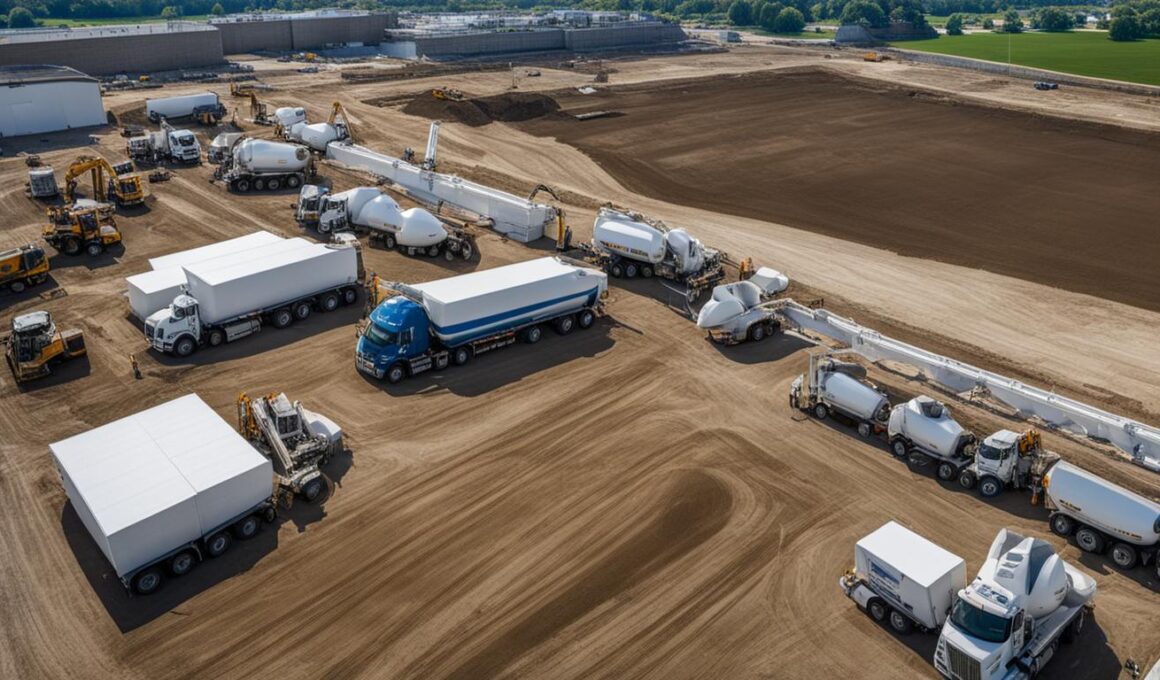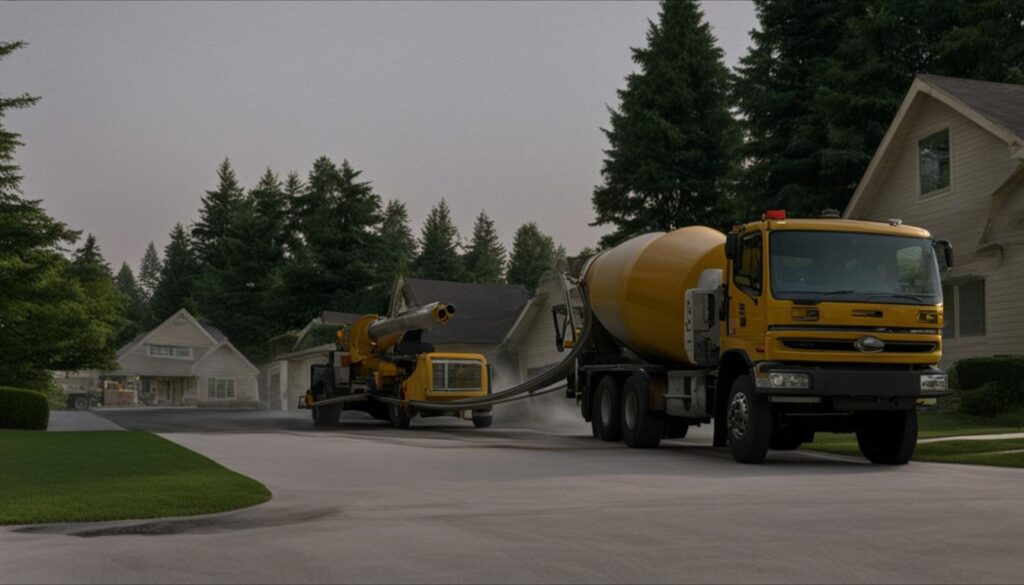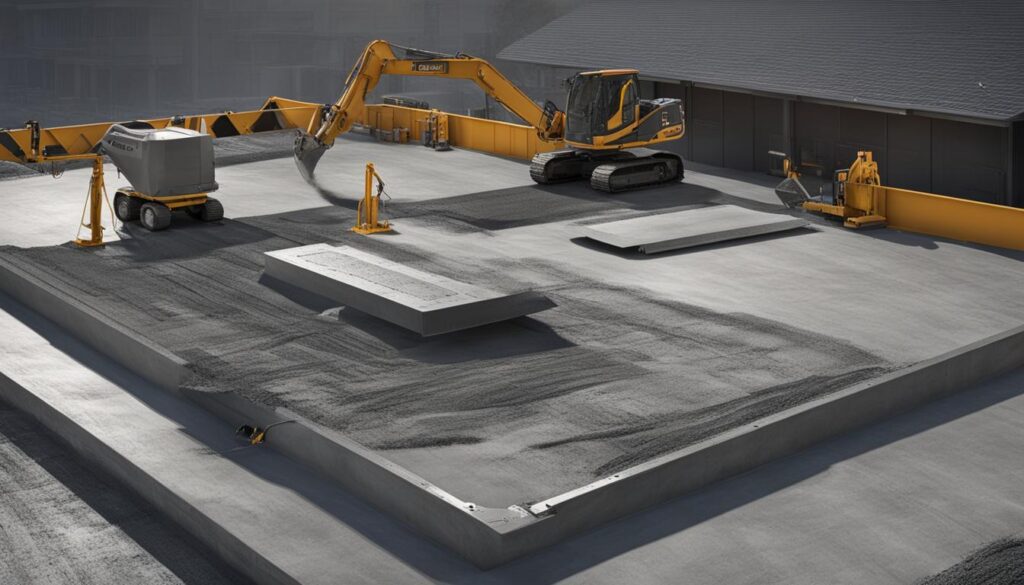Are you in need of concrete for your next construction project in Ohio? Understanding the cost of concrete per yard is essential for budgeting and planning. In this article, we will reveal the average concrete prices in Ohio and provide valuable insights into the factors that can affect the price.
Concrete in Ohio is priced, on average, at $117 per cubic yard. However, the actual cost can vary depending on various factors such as the distance from the delivery company, the quantity of the concrete ordered, and the specific type of concrete required.
If you are ordering less than a truckload of concrete, expect an additional $43 per cubic yard. On the other hand, buying in bulk, such as a full truckload or more, falls within the typical price range of $104 to $144 per cubic yard.
By understanding the Ohio concrete prices and the factors influencing them, you can accurately estimate your concrete costs and plan your construction project accordingly. Read on to discover the key factors affecting concrete prices and how to estimate the quantity of concrete you’ll need for your project.
Factors Affecting Concrete Price in Ohio
When it comes to pricing concrete in Ohio, several factors can influence the final cost. Understanding these factors is essential for homeowners who want to plan and budget effectively for their concrete needs.
Concrete Strength
The strength of the concrete is one of the primary factors that can affect its price. Higher strength concrete typically costs more per cubic yard. Depending on the project requirements, homeowners may need to opt for a higher strength concrete, such as for heavy-duty applications or load-bearing structures.
Delivery Distance
The distance of delivery from the mixing plant to your location can also impact the cost of concrete. Delivery fees may be charged based on the distance traveled, with an average charge of $9.75 per mile. So, the farther you are from the mixing plant, the higher the delivery cost may be.
Day of Delivery
The day of delivery is another factor that can affect the price of concrete. Some companies may charge additional fees for weekend deliveries. If possible, scheduling your concrete delivery during weekdays can help you avoid these extra charges.
Purchasing Pre-Mixed Concrete Bags
As an alternative to ready-mix or short load delivery, homeowners can choose to purchase pre-mixed concrete bags from a home improvement store. This option can be convenient for smaller projects or minor repairs. However, it’s important to note that the cost per bag varies depending on the type of concrete required, such as fast setting, mortar mix, high early strength cement, Portland cement, or masonry cement.
Estimating Concrete Quantity
When planning a concrete project, it’s important to accurately estimate the quantity of concrete needed. This will help you budget effectively and ensure you have enough materials on hand. To calculate the quantity of concrete required for your project, you can use simple formulas based on the shape of the area you’re working with.
Calculating for Square or Rectangular Slabs
If you’re working with a square or rectangular slab, you’ll need to consider the thickness, width, length, and height. First, convert the thickness to feet. Then, multiply the thickness by the width, length, and height to determine the total volume in cubic feet.
Volume = Thickness (in feet) * Width (in feet) * Length (in feet) * Height (in feet)
After calculating the volume in cubic feet, divide it by 27 to convert it to cubic yards. This will give you the estimated amount of concrete needed for your square or rectangular slab.
Calculating for Circular Slabs
If you’re working with a circular slab, you’ll need to account for the thickness, radius, and height. Begin by converting the thickness to feet. Then, calculate the volume by multiplying the radius squared by the height and 3.14 (π).
Volume = (Radius^2) * Height * 3.14
Once you have the volume in cubic feet, divide it by 27 to obtain the volume in cubic yards, which represents the approximate amount of concrete required for your circular slab.
By accurately estimating the quantity of concrete needed for your project, you can avoid overspending on materials and ensure a smooth construction process. Use the provided calculations for square or rectangular slabs and circular slabs to plan your concrete needs effectively.
Concrete Pricing Examples
When planning your concrete project, it’s important to understand the cost implications. The price of concrete can vary depending on the quantity ordered. Let’s take a look at a specific example to give you a better idea:
Imagine you need to pour a concrete slab that measures 10 feet long, 15 feet wide, and has a thickness of 5 inches. To calculate the amount of concrete needed, you can use the cubic yard measurement. In this case, the slab would require approximately 2.33 cubic yards of concrete.
The total cost for this amount of concrete will include additional fees, such as the short load fee. Taking these into account, the cost of the concrete for this slab would fall between $343 and $436. This estimated cost provides a range to account for variations in delivery and other factors.
Keep in mind that these examples are specific to the given measurements and may not apply to your exact project. Prices may vary based on location, distance, and other factors. To get a more accurate cost estimate, it’s always best to consult with concrete suppliers or contractors in your area.
For a comprehensive breakdown of different cubic yard measurements and their corresponding costs, refer to the pricing table provided below:
In the pricing table, you will find various measurements and their corresponding costs per cubic yard. This table can serve as a reference point to help you estimate the total cost for your specific project. Keep in mind that additional fees, such as delivery charges, may apply depending on your location and other factors.
By understanding the cost implications of concrete slabs and using these pricing examples and the provided table as a guide, you can better plan and budget for your concrete project.
Delivery Costs and Options
When ordering concrete for your project, it’s important to consider the delivery options available to you. Two common methods are ready-mix delivery and short load delivery. Each option has its advantages and considerations, so let’s take a closer look.
Ready-Mix Delivery
Ready-mix concrete is a popular choice for larger construction projects. With this method, the concrete is mixed at a central plant and then transported to your location. This ensures consistent quality and saves you the hassle of on-site mixing.
However, it’s important to note that ready-mix delivery comes with concrete delivery costs. The cost of delivery can vary based on the distance between the mixing plant and your project site. Typically, there is an additional fee per mile beyond a certain radius.
Short Load Delivery
If you’re working on a smaller to medium-sized project, short load delivery might be a more suitable option. With short load delivery, the concrete is mixed on-site using portable mixing equipment. This allows for flexibility and ensures that you only pay for what you need.
One advantage of short load delivery is that you can avoid excessive concrete delivery costs associated with long-distance transportation. However, keep in mind that on-site mixing requires some additional labor and equipment setup time.
As you plan your project, it’s essential to consider your specific needs and budget. Ready-mix delivery offers convenience and consistency for larger projects, while short load delivery provides flexibility and cost control for smaller ones. Additionally, keep in mind that delivery on weekends may incur extra charges.
By understanding the delivery options available to you and considering factors such as distance and project size, you can make an informed decision that suits your needs and ensures the successful completion of your concrete project.
Buying Pre-Mixed Concrete Bags
If you prefer a DIY approach, you have the option to purchase pre-mixed concrete bags from your local home improvement store. This can be a convenient and cost-effective solution for small to medium-sized projects.
You’ll find a variety of pre-mixed concrete bags available, each designed for different applications. Whether you need fast setting concrete, mortar mix, high early strength cement, Portland cement, or masonry cement, the store will have the right type for your specific project.
The cost of pre-mixed concrete bags can vary depending on the type and brand chosen. It’s important to check the price per bag and calculate how many bags you’ll need to make up one cubic yard of concrete. To do this, divide the total volume of one cubic yard, which is 27 cubic feet, by the volume provided by each bag type.
Step-by-Step Guide:
- Determine the specific type of pre-mixed concrete bag you need for your project.
- Check the price per bag at your local home improvement store.
- Calculate the number of bags needed to make up one cubic yard of concrete by dividing 27 cubic feet by the volume per bag.
- Ensure you purchase enough bags to complete your project, considering any additional waste or margin for error.
Buying pre-mixed concrete bags can be a convenient and budget-friendly alternative to ready-mix or short load delivery. Just make sure to choose the right type of pre-mixed concrete and calculate the number of bags needed for your desired quantity. With the right preparation and materials, you’ll be on your way to successfully completing your concrete project.
Factors Affecting Concrete Slab Foundation Costs
The cost of a concrete slab foundation can be influenced by several factors. One of the primary factors is the size of your home. Generally, larger homes require more expensive foundations due to the increased amount of concrete needed for the larger footprint.
Another factor that can impact the cost is the geographical location. Areas with a higher cost of living often have higher concrete prices, which can affect the overall price of your foundation. It’s important to consider this factor when estimating your foundation costs.
The soil type in your area is also a significant factor to consider. Certain types of soil may require additional work such as soil compaction or ground preparation, which can increase the overall cost of your foundation. It’s advisable to consult with a professional to assess the soil conditions and determine if any additional steps are necessary.
By considering these factors and understanding their influence on the price, you can better estimate the cost of your concrete slab foundation. Planning and budgeting accordingly will help ensure a successful and cost-effective foundation for your home.
When planning your concrete slab foundation, take into account the size of your home, the geographical location, and the soil type in your area. These factors can significantly impact the overall cost of your foundation. By considering these factors and understanding their influence on the price, you can better estimate the cost of your foundation before beginning your construction project.
What is the Volume of Concrete Needed for a Project in Ohio?
When calculating the volume of concrete needed for a project in Ohio, it’s essential to consider the volume conversion in quarts. By converting the measurements into quarts, you can accurately determine the amount of concrete required for the job. This ensures that the project is completed efficiently and within budget.
Conclusion
Determining the cost of concrete per yard in Ohio is crucial for homeowners planning construction projects. By considering factors such as the quantity of concrete needed, the type of concrete required, and the delivery distance, you can estimate the total cost accurately.
Using the provided calculations for square or rectangular slabs, as well as circular slabs, you can estimate the concrete quantity required for your project. This estimation will help you plan and budget effectively.
Remember, various factors affect concrete prices, including strength, delivery distance, and the day of delivery. Additionally, purchasing pre-mixed concrete bags from a home improvement store can be a cost-efficient alternative for smaller projects.
By understanding these factors and considering the specific requirements of your project, you can navigate the Ohio concrete market with confidence and ensure accurate cost estimation for your concrete needs.











